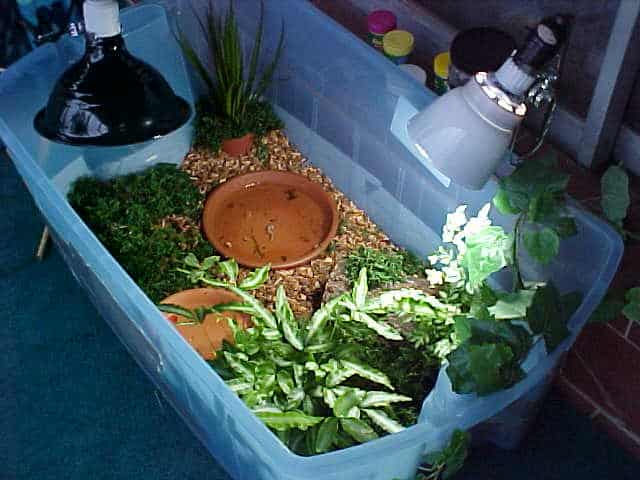In contrast to humans, box turtles and other reptiles can’t regulate their own body temperature. When the temperature around them falls, their body temperature also falls, causing the box turtle to move slower, stop eating and eventually go into hibernation. if expsed to lower temperature for a longer time. Once the surrounding temperature rises, the body temperature of a turtle also increases. Therefore, it is crucial to provide the right temperature, humidity levels and UVA and UVB lighting for the health your box turtle. This post provides and overview of the perfect box turtle enclosure temperature for different box turtle species. You will also learn how to provide the ideal temperature, humidity and UVA and UVB levels for your box turtle.
This post contains affiliate links. At no extra cost for you, we may receive a commission if you purchase products mentioned below.
Effects of a suboptimal temperature
If you are keeping your box turtle indoor at too low temperatures, the body temperature of your box turtle will be too low as well. In that case, the turtle will start to slow down and eat less.
Failing to provide the right temperature for your turtle for an extended period of time means that your box turtle may get weaker and be more vulnerable to various diseases.
Therefore, you should provide your box turtle with extra heat throughout the day with a heat lamp or a different heating source. The heat lamp should be kept on for 10-14 hours a day. During the warmer summer months, 10 hours a day should be enough. During the cooler winter months and for box turtle hatchlings or sick box turtles, you should keep the heating lamp on for up to 14 hours a day.
With some time, you will learn the temperature needs of your box turtle and you can adjust accordingly.

If you are feeding your box turtle in the morning, make sure to turn on the heat source some time before the feeding. This way, the turtle can adjust its body temperature beforehand. Otherwise, it may refuse to eat.
Click here to learn more about the ideal diet for box turtles.
Box Turtle Temperature and Humidity Needs
Below you can find the ideal temperatures and humidity levels for the various types of box turtles. Since Western Ornate and Florida box turtles are native to warmer areas they need higher temperatures and lower humidity levels than Eastern box turtles or Three-Toed box turtles.
Temperature and Humidity for Eastern Box Turtles
- Daytime Temperature: 70-75°F (21-24°C)
- Basking spot (one side of the habitat, see more below): 85-88°F (29-31°C)
- Nighttime Temperature: 65-70°F (18-21°C)
- Humidity: Around 60%, higher for hatchlings
Temperature and humidity for Western Ornate Box Turtles and Florida Box Turtles
- Daytime Temperature: 70-90°F (21-32°C)
- Basking spot (one side of the habitat, see more below): 85-88°F (29-32°C)
- Nighttime Temperature: 65-75°F (18-24°C)
- Humidity: Around 40%, higher for hatchlings
More information about the Ornate box turtle can be found here.
Temperature and humidity for Three-Toed Box Turtles
- Daytime Temperature: 70-75°F (21-24°C)
- Basking spot (one side of the habitat, see more below): 85-88°F (29-31°C)
- Nighttime Temperature: 65-70°F (18-21°C)
- Humidity: Around 60%, higher for hatchlings
The importance of UVA and UVB for your box turtle
Just like us humans, bux turtles need sunlight for their physical and psycologial health. The two most important elements of sunlight next to the emitted heat are UVA and UVB rays.
UVA rays are within the visible range for box turtles and they are responsible for the well-being of your box turtle. UVA lights increase the overall activity level of a box turtle, its appetite, and its desire for mating.
UVB rays are not visible for bux turtles. Reptiles like box turtles need UVB light to synthesize vitamin D3. D3 is a vitamin that helps the turtle absorb calcium. IF your box turtle does not get enough UVB, it will not be able to absorb enough calcium from its diet in order to produce a healthy shell. The consequence may be shell deformations or metabolic bone disease.
UVA and UVB rays cannot penetrate the windows of your house. Therefore, if you keep your box turtle in an indoor habitat, you need to provide it with a lamp that emitts UVA and UVB rays.
The ideal ReptiSun UVA/UVB lamp for your box turtle
ZooMed ReptiSun bulbs are the market leader for UVA/UVB lamps for reptiles. One bulb emits both UVA abd UVB radiation.
There are several varieties of UVA/UVB lamps available with different intensities and wattages.
How to choose the right intensity and wattage
Depending on how far from the animal your lamp will be installed, you can find the right lamp product from the table below:
| Distance Lamp to Box Turtle | ReptiSun 5.0, 13 Watt | ReptiSun 10.0, 13 Watt | ReptiSun 5.0, 26 Watt | ReptiSun 10.0, 26 Watt |
| 5 inches (13cm) | X | X | ||
| 6 inches (15cm) | X | X | X | |
| 7 inches (18cm) | X | X | X | |
| 8 inches (20cm) | X | X | X | |
| 10 inches (25cm) | X | X | ||
| 12 inches (30cm) | X |
Follow this table and do not place a too strong lamp too close to your box turtle. Too much heat and UVA/UVB can just be as bad as too little. Eccessive UVA lighting may cause skin irritations or cancer for your turtle.
Click here to get to our detailed instructions how to build an indoor or outdoor box turtle enclosure. If you are raising a baby box turtle, you can learn how to build a habitat here.
Unless your light installation is rather high up, I would suggest that you stay with the 13W bulbs. They are significantly cheaper with a similar lifespan and the risk over over-exposure of your turtle is lower.
Replace the ReptiSun bulb every 6-9 months. Even if the bulb is still working, after some time, the emitted UVA/UVB will decrease. If this happens, your box turtle would be able to absorb less calcium, which could lead to shell deformations in younger box turtles, metabolic bone disease or other health issues.
If outside temperatures allow it, try to get your box turtle outside as much as possible, even if you have a UVA/UVB lamp set up inside. Real sunlight also carries UVA and UVB and helps keep your box turtle happy and healthy.

Box Turtle Tank Heater
There are several ways to reach the necessary temperature of around 75°F inside the turtle tank. Some turtle habitats come with a built-in heating function that heats the enclosure from the bottom.
Since box turtles need various climate zones within their habitat, we recommend you to use an overhead heating source. By fixing the heating source on one side of the tank, your box turtle can decide if it wants to stay on the cooler side or if it wants to bask in the warm temperatures under the heat source.
Tip: Do not use heating stones that are sometimes advertised as great options to regulate a turtles body temperature. They often lead to serious burns and other health issues.
Since you need to regulate the temperature throughout day and night inside the enclosure, make sure to avoid light-emitting heat sources. Too much light can disturb the sleep of your turtle, which leads to stress and health issues.
For a medium sized indoor box turtle habitat, we recommend using the ceramic infrared head emitter from ReptiZoo. A ceramic infrared heater will not disturb the sleep of your box turtle since it doesn’t emit any visible light. At the same time, it maintains the ideal temperature within the enclosure.
Depending on the distance from the bottom of the enclosure, you need a lamp with the following wattage:
- 8 inches (20 cm): 75 Watt
- 10 inches (26 cm): 100 Watt
- 12 inches (30 cm): 15 Watt
Position of the UVA/UVB Lamp and the Heat Lamp
The heat source and the UVA/UVB lamp should be placed on the same side of the turtle tank. Due to the higher temperature, this is the part of the enclosure where your box turtle will spend a lot of its time to bask in the heat. Especially in the morning when it needs to warm up its body.
While basking in the warm, it will be able to absorb the important UVA and UVB. You should also place the eating area and the water area in the warmer zone of the enclosure.
To fix both the UVA/UVB lamp and the heating lamp, you can use a dual fixture for reptile tanks from ReptiZoo or Zoo Med.
Monitoring temperature and humidity inside the turtle tank
Once installed, make sure to monitor the temperatures and the humidity before moving your box turtle into its new home.
Monitor the temperatures over a couple of days in several areas of the box turtle pen. Is the temperature in the basking area in the appropriate range for your type of box turtle (see above)? What about the humidity levels? Also make sure that the temperature on the side away from the heating source is actually lower so your box turtle can find a cooler place if it wants to.
You can either measure the temperature and humidity locally with an inexpensive thermometer or place a wireless thermometer and hygrometer inside the habitat. That way, you will have access to the temperature and humidity development over a period of up to 20 days.


6 thoughts on “Light, Temperature and Humidity for Box Turtles”
Comments are closed.